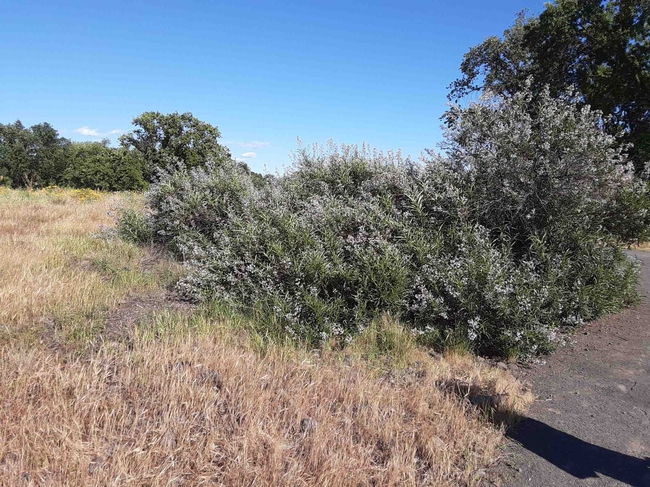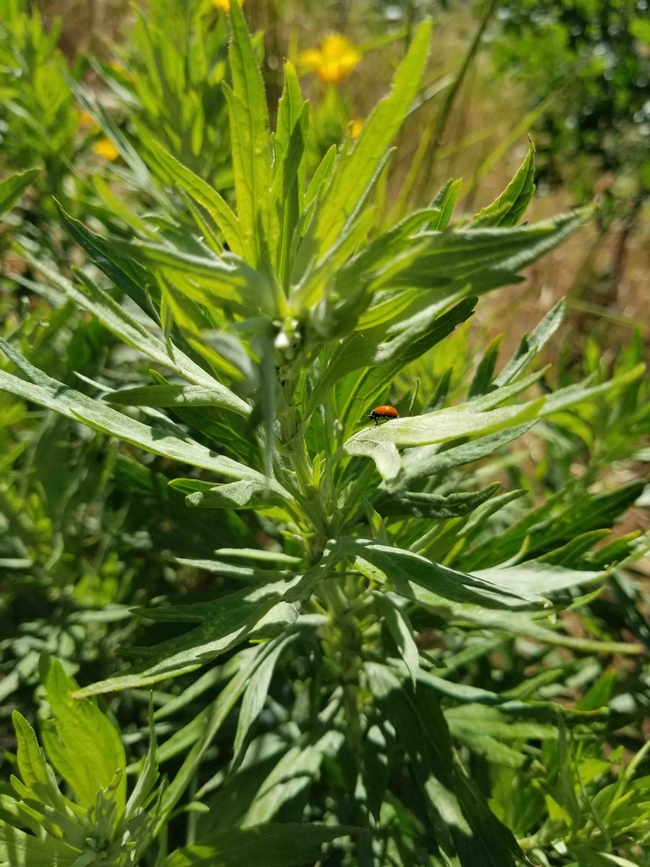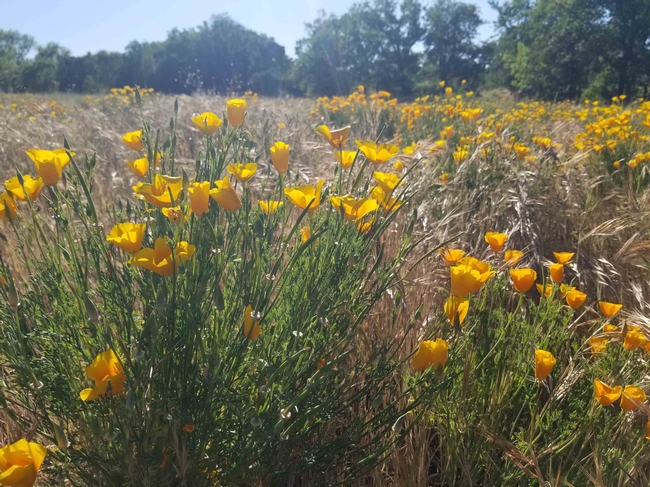April's Wildtending Walk at Verbena Fields marked the third of this year-long monthly series. Each month, we discover changes that have taken place and learn the stages of a plant's growth (e.g. leaf, bloom, seed). One goal is to develop an intuitive sense of when and how to gather seeds of different species, with a broader goal of helping people develop an understanding of local ecology from a native peoples' perspective in which humans are not separate from nature, but an equal participant and keystone species that interacts with and influences plant evolution and propagation. Some of the plants focused on during this walk are also keystone species: important components in the lore, culture practices and survival of the Mechoopda people who inhabited this land for thousands of years prior to occupation by Europeans.

As fluffy cottonwood seeds floated in the air, the group headed towards the channel and stopped at a cottonwood. These trees are a primarily riparian species that can also handle drought. Meders-Knight noted that their seeds float along hoping for a flood year. Each tree puts out many thousands of seeds and gambles that a few will land in enough moisture to enable them to take root and grow to maturity. Humans can help by collecting the cottony seed pods and dropping them into welcoming habitat.
The cottonwood's medicinal properties include interacting with fungus and as an antiseptic. In addition, buds can be soaked in oil to make a pleasantly-scented tincture to ease muscle pain. The inner bark, buds, and catkins are edible. Mechoopda people found cottonwood ideal for a fire-starting plank – the tree is a softer hardwood that is easy to drill into to make sawdust. (Cedar makes the best fire planks but does not grow in the valley.)

An enormous yerba santa perched along a high spot above the channel was planted seven years ago as a tiny start. by Meders-Knight. Since then she has used this specimen to show kids how to sample plants, and it has responded to the honor of being a teaching plant by growing into a huge shrub, right now in its flowering stage. European honeybees and several types of native bees are mobbing this bush. It blooms at a good time of year to nurture these pollinators. It's not quite ready to give up its seed– perhaps next month. Yerba santa seeds will not sprout without having been exposed to fire.

Meders-Knight calls the yerba santa a “backwards chewing gum” plant as the leaves initially taste unpleasant and sweeten up with chewing (whereas chewing gum starts out sweet and ends up icky). Yerba santa leaves are helpful for dehydration and can also act as a stimulant. As she plucks these leaves and drops them in her water bottle, Meders-Knight emphasizes the importance of staying mindful and being thankful while gathering. She gathers for medicinal and educational purposes, and honors and respects what the plant offers. Traditionally, jewelry might be offered in thanks, and she demonstrates how strands of hair can be wound on the plant in return for sharing its leaves and seeds.
Yerba santa absorbs, even thrives on, carbon monoxide, and it likes to grow on roadsides. This plant can be smoked: pick and dry leaves, then crumble, roll, and smoke them to help clear your lungs. Meders-Knight noted that smoked with cannabis it can soothe lungs that have been scarred from wildfire smoke, like those of firefighters. She cautions to gather from plants growing in interior areas, away from constant car exhaust. One can also make a cough syrup from yerba santa. Breathing in steam from boiling this plant or steeping it to make tea can also soothe lungs.

DiGenova finds the fruit of a pipevine, which is exciting as there is a very short window of time to gather seeds of this plant, and the seed pods are camouflaged within the foliage. Each pod can carry fifty or more seeds. Since seeds fall straight down it is hard for this plant to spread itself to other parts of the park. They'd like to seed many more of these in order to beef up the pipevine swallowtail butterfly population. Look for an area at the bottom of the seed pod that is just barely open: this means that the seeds are ripe to pick but seeds have not yet dropped. Scatter them at the base of other trees, as pipevines need a support structure to grow on, or along the willow walls woven along the sides of the channel.
Verbena Fields is home to a bush that grows abundantly in our valley: the elderberry, a keystone Mechoopda species with high intrinsic value. Straight narrow twigs from this bush are made into clapper sticks which the Mechoopda use for percussion during ceremonies and songs. Elderberry twigs also make excellent drill sticks to use with the cottonwood plank. Native stories recount firebirds playing with and stealing the people's drill sticks.
The elderberry bloom this year was huge, perhaps prompted by our scant rainfall. Their berries are very popular with birds, who repay in kind by spreading the seeds in their droppings. Propagation also occurs through root sprouts.
The elderberry has many medicinal and nutritional uses. The berries and flowers of elderberry are packed with antioxidants and vitamins. It can be used to reduce inflammation, lessen stress, and to relieve cold and flu symptoms. Use care when working with this plant: prior to blooming, the green berries have high amygdalin concentrations. Amygdalin is a cyanogenic glycoside which can result in cyanide poisoning. Stems and leaves also contain this toxic compound. For this reason, remove any stems from flowers when making elderflower tea and never make tea from elderberry leaves. The ripe fruit, however, contains no poisons and has anti-viral properties.

The group circles back to revisit the redbud. Its flowering stage is complete and its branches sport many green and pliable seedpods, along with some that have dried. The redbud is also a Mechoopda keystone species, as leaves, seeds, and flowers are all nutritious and delicious. Pods are best eaten when still young.
The walk ends with the collection of California poppy seeds. It is just a tad bit early in their season, so DiGenova teaches how to identify the seed pods that are closest to ripe. The long slender pod develops dark vertical stripes when close to optimum ripeness, and one good clue is if most of the flowers on any given plant are spent. Test with a slight twist and tug at the base of the pod: the ripest ones will detach easily. When completely dry, pods pop open and seeds are ejected forcefully into the areas surrounding these beautiful, hardy plants. An annual, poppies rely on seeding to propagate. The group spreads out over the field, dropping pods into the collection bags to return to DiGenova for planting later; we are encouraged to pocket some to watch them pop open (and perhaps sow) at home.

There are three ways you can get involved and learn more about this special place, native species, and the Mechoopda culture: 1) Join the Wildtending Walks the last Tuesday of the month. There is a suggested $5 donation to support the facilitators; 2) Meet up with the volunteer crew at Verbena Fields every Friday between 10 and 1 to pull invasives, water seedlings, and more; and 3) Become certified in native plants through Meders-Knight's TEK training workshops.
The Master Gardeners 2021 Spring Workshop Series continues in June with “The Wild and Wonderful World of Honeybees” on Wednesday, June 16. Register for this free workshop on our website.
UC Master Gardeners of Butte County are part of the University of California Cooperative Extension (UCCE) system. To learn more about us and our upcoming events, and for help with gardening in our area, visit our website. If you have a gardening question or problem, email the Hotline at mgbutte@ucanr.edu (preferred) or call (530) 538-7201.